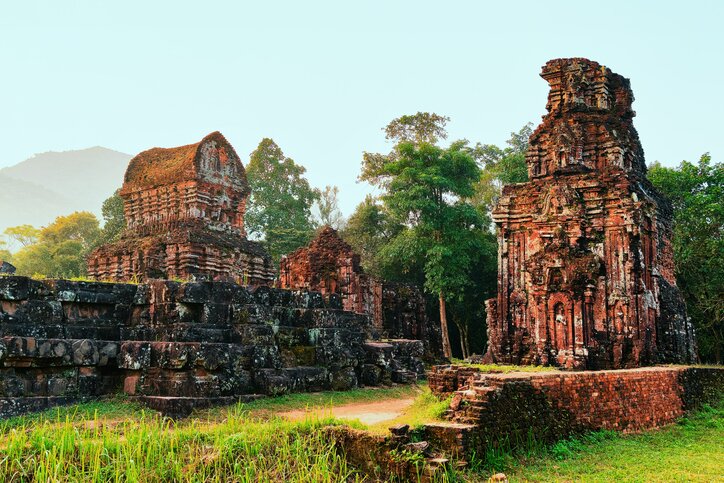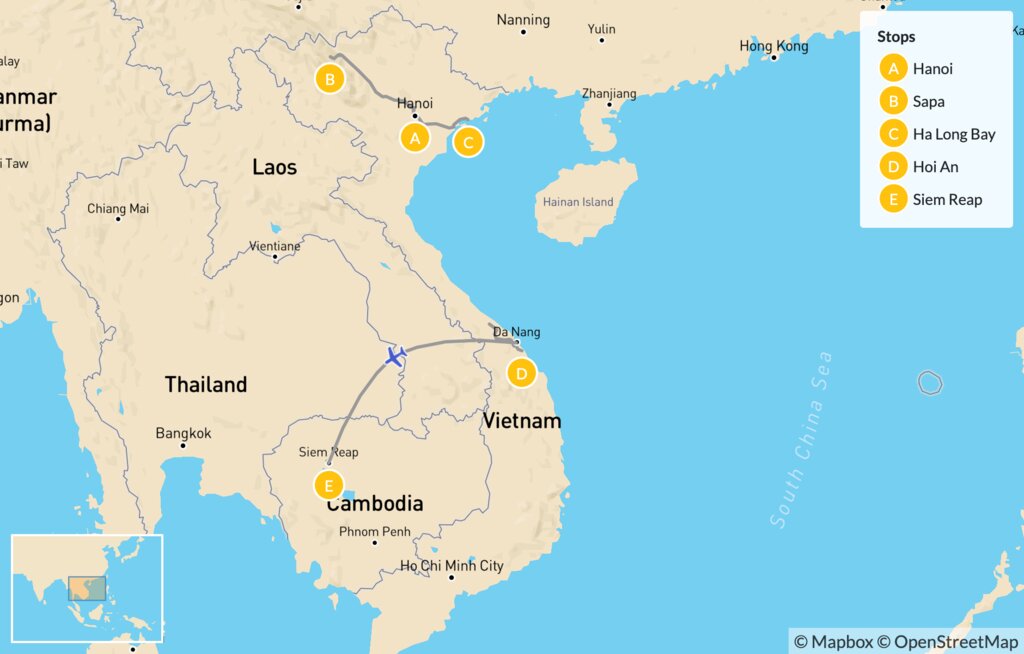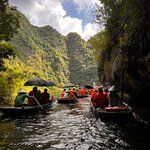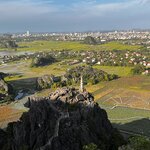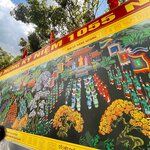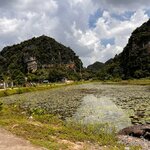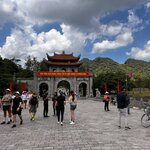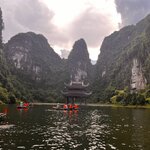Highlights
- See the highlights of Hanoi and hike the mountains of Sapa
- Cruise Ha Long Bay and swim in secluded lagoons
- Tour ancient Hoi An and the surrounding river villages
- Visit Cambodia and the ancient temples of Angkor
Brief Itinerary
| Day | Highlights | Overnight |
|---|---|---|
| Day 1 | Arrive in Hanoi | Hanoi |
| Day 2 | Hanoi City Tour, Transfer to Sapa | Sapa |
| Day 3 | Hike to a Rural Village | Sapa |
| Day 4 | Day Hike Around Sapa | Sapa |
| Day 5 | Hanoi to Ha Long Bay, Cruise & Activities | Ha Long Bay |
| Day 6 | Fly to Da Nang, Transfer to Hoi An | Hoi An |
| Day 7 | Visit Fishing Village & Hoi An Tour | Hoi An |
| Day 8 | Day Trip to My Son Sanctuary | Hoi An |
| Day 9 | Transfer to Da Nang, Fly to Siem Reap (Cambodia) | Siem Reap |
| Day 10 | Angkor Highlights Tour | Siem Reap |
| Day 11 | Angkor Thom & Angkor Wat Day Tour | Siem Reap |
| Day 12 | Boat Tour of Tonlé Sap, Depart Cambodia |
Detailed Itinerary
Day 1: Arrive in Hanoi

Day 2: Hanoi City Tour, Transfer to Sapa

In the morning, you're off to discover the beauty and history of Hanoi on a full-day tour. First, you'll visit the Ho Chi Minh Mausoleum to see the final resting place of "Uncle Ho." Continue on to the 11th-century Temple of Literature, which is dedicated to Confucius. Fun fact: this temple was the first-ever university in Vietnam, and even today, students burn incense and pray at its altars for academic success.
After a lunch of traditional pho (Vietnamese noodle soup) at a local restaurant, you can visit one of the numerous museums and temples around Hanoi. Top options include the Women's Museum, the National Historical Museum, and Quan Thanh, an 11th-century Taoist temple. Another highlight is the Museum of Ethnology, which preserves the cultural heritage of the 54 different ethnic groups in Vietnam.
Later in the afternoon, take a bicycle ride around Hoem Kiem Lake. Located in the Old Quarter, this is one of the best places to experience typical Hanoian life and Vietnamese culture. Finish the tour with some traditional Vietnamese entertainment: a water puppet show. It's an art that has been practiced in this part of Vietnam for centuries. Afterward, you'll return to your hotel, but the day isn't over. At around 7:30, you'll board an overnight train north to the highland area of Sapa, which is known for its soaring mountains and endless terraces of green rice paddies.
Day 3: Hike to a Rural Village

Eat a hearty breakfast because this morning, you'll embark on a 3.5-hour hike to a traditional village through the mountains of Sapa. The excursion begins at 8:30 am with a transfer deep into Hoang Lien National Park. This is the main national park in the Sapa region, covering 169,437 acres (68,569 ha) of unspoiled highland landscapes. You'll arrive at the trailhead near Sin Chai village, and from there, head out on backcountry tracks amid stunning views of mountains, waterfalls, and the deep valleys below.
The trail leads to Nam Nhiu, a village home to the Red Dao ethnic group. Like the Black Hmong, Tay, and Giay people of this region, the Red Dao is a nomadic tribe that migrated from China to northern Vietnam centuries ago. Upon arrival, you'll meet the villagers, visit a local home, and learn about their daily life, which is based around agriculture. Eventually, you'll leave the village and follow a dirt trail along terraced rice paddies dotted with bamboo huts.
Your destination is Nam Cang village, where you'll enjoy a traditional lunch served at a riverside lodge. This is one of the most remote areas of Sapa, and after lunch, your guide will take you around to see how locals have been living much the same as they have for hundreds of years. The women still wear brightly colored traditional garments, as the villagers here are highly skilled at embroidery. They also make their own rice paper, jewelry, and even medicine. In the afternoon, you'll arrive at the ecolodge where you'll overnight. There's also a spa where you can relax after your long hike.
Day 4: Day Hike Around Sapa

Wake up and enjoy breakfast and coffee on your private balcony in the ecolodge. Afterward, you'll embark on a brisk 2.5-hour hike through the countryside. On this scenic outing, you'll pass terraced rice fields and stop at local villages like Lech. You'll even be welcomed into a traditional wooden home in the countryside to meet the hosts and have a cultural exchange.
After spending time learning about the culture and traditional farming methods practiced by your Red Dao hosts, you'll return to the ecolodge. The route back passes more stunning scenery and even crosses a suspension bridge, which offers panoramic views of Sapa in all its glory. And every step of the way, your guide will be there to act as a translator and help explain the ancestral history of the region.
Chat with a local specialist who can help organize your trip.
Day 5: Transfer to Ha Long Bay, Cruise & Activities

Wake up early and hop in a shared van for the four-hour ride from Hanoi to Ha Long Bay. This UNESCO World Heritage Site is one of the true natural wonders of the world. In this sweet spot where the land meets the Gulf of Tonkin, over 1,000 karst islets rise above emerald waters, and the seascape takes on an otherworldly quality.
You'll arrive at the marina around noon and board the ship. After a luxurious lunch served outdoors, you'll then get underway. The ship will pass a number of islets before arriving at a secluded lagoon in Lan Ha Bay, which is just south of Ha Long. Here, the boat will drop anchor, and you'll have time for kayaking, swimming, or sunbathing on the boat. In the late afternoon, everyone will gather on deck to witness the golden sunset over the water—complimentary cocktails included.
After enjoying a barbecue dinner of fresh seafood, you can spend the evening relaxing. Have a drink at the bar or get an onboard massage. You can also opt for activities like games and movies or head out on a nighttime squid-fishing excursion.
Day 6: Fly to Da Nang, Transfer to Hoi An

Begin your day with a tai chi session on the ship's sundeck accompanied by complimentary tea and coffee. After breakfast, you can choose an activity like kayaking around the bay or paddling in a rowboat. Enjoy lunch on the boat, then return to the marina, where you'll hop in a vehicle back to Hanoi and the airport for a 1.5-hour flight to Da Nang.
From Da Nang, it's a 1.5-hour transfer south by car to Hoi An. This small city of just over 100,000 people sits on the banks of the Thu Bon River and is a real treasure. Its Ancient Town is a UNESCO World Heritage Site and one of the most impressive and historic city centers in the country. Upon arrival, your driver will take you to your hotel, where you'll overnight.
Day 7: Visit Fishing Village & Hoi An Tour

In the morning, meet your guide at the hotel and transfer down the river from Hoi An to a traditional fishing village. Here, you'll get a glimpse into the lives of the locals as they ply their trade. Each day they head out on traditional basket boats called thung chai to cast nets for shrimp, crabs, and fish. You'll join right in, learning how to prepare the nets before heading out on the water to go fishing yourself.
Afterward, take a leisurely ride in the basket boat down the river, passing the coconut-fringed banks on your way to a small village. Here, you'll sit down to a delicious local lunch. Then, hop on a bicycle for a scenic ride down a country road alongside green rice paddies as you make your way back to Hoi An. After touring some of the city's famous sights, like the Japanese Covered Bridge and the historic Chinese meeting hall Phuc Kien, you'll return to your hotel.
Day 8: Day Trip to My Son Sanctuary

After breakfast, you'll transfer an hour inland to the My Son Sanctuary. This archeological site is unique to Vietnam in that it consists of Hindu tower temples built between the 4th and 13th centuries in honor of the god Shiva. They represent what was once the spiritual and political capital of Champa, an ancient Indochinese kingdom that extended to the central and southern coasts of Vietnam.
You'll spend time touring the red-brick temples here and admiring their ornate sandstone bas-reliefs depicting scenes of Hindu mythology. Afterward, you'll enjoy a performance of traditional Hindu music. Then, board a boat for a scenic ride up the Thu Bon River back to Hoi An and your hotel.
Day 9: Transfer to Da Nang, Fly to Siem Reap (Cambodia)

Today you'll transfer back to Da Nang and the airport, where you'll catch a flight to Siem Reap. This town in northwest Cambodia sits on the shores of Tonlé Sap lake and is the gateway to the UNESCO World Heritage Site of Angkor. These ruins were once the capital city of the Khmer Kingdom from the 9th to the 15th centuries. Upon arrival in Siem Reap, you'll transfer to your hotel and have the evening free. For dinner, try the famous Khmer curry.
Day 10: Angkor Highlights Tour

In the morning, you'll embark on a tour of some of the most impressive landmarks in Angkor. First up is Banteay Srey, a 10th-century Hindu temple made of pink sandstone, almost every inch of which is adorned with intricate designs. The name Banteay Srey translates to "Citadel of Women," and there's a high probability the elegant carvings depicting deities and scenes from the Sanskrit epic "Ramayana" were done by women. Whoever built it, the consensus is that Banteay Srey represents the finest example of Khmer art in the world.
You'll also visit another 10th-century temple, Prasat Kravan. Comprised of five brick towers, in the center tower are sculptures of Vishnu and his consort Lakshmi. There are also bas-reliefs depicting Vishnu and worshipers, as well as scenes from the sacred Hindu text "Bhagavata Purana." Next, stop at Srah Srang ("Royal Bath"), a reservoir dug in the 10th century that was used for ritual bathing.
Continue to Ta Prohm, a 12th-century Buddhist temple left mostly untouched since it was first discovered. The result is that the encroaching trees, lichens, and creeping vines of the surrounding jungle appear to be overtaking the crumbling towers, stone walls, and bas-reliefs of this spectral temple. Other highlights include Neak Pean, an artificial island in a man-made pond topped by a Buddhist temple, and Preah Khan, a temple complex built by King Jayavarman VII and dedicated to his father in 1191. Adorning its stone walls are impressive sculptures of garudas—mythological, eagle-like beings.
Day 11: Angkor Thom & Angkor Wat Day Tour

Today you'll visit Angkor Thom (literally "Great City"), which comprises the ruins of what was once the most impressive royal city of Cambodia's Angkor period. During its heyday in the 12th and 13th centuries, it was also a formidable defensive area, protected by 26-foot (8-m) walls and a wide moat.
Looming over Angkor Thom is Bayon Temple. Comprised of 54 Gothic towers, Jayavarman VII commissioned it in the 12th century, whose smiling face and glaring eyes are represented in its 216 stone sculptures. The primary structure consists of three levels, with bas-reliefs decorating the first two floors and stone figures on the third. Other structures you'll visit here include the Terrace of the Elephants (featuring sculptures and bas-reliefs of elephants), Phimeanakas (a three-tiered pyramid), and the Terrace of the Leper King, known for its carvings of demons and mythological figures.
After Angkor Thom, you'll tour the most famous temple of all: Angkor Wat. This 12th-century complex covers 200 acres (81 ha) and is roughly the size of Beijing's Imperial Palace. Its five towers are so iconic that they're actually emblazoned on the Cambodian flag. The complex itself is considered the premier example of Khmer art and architecture. On this walking tour, you'll immerse yourself in the ruins as you stroll through its galleries, libraries, pavilions, and courtyards. Cap the experience with a sunset from the top of Pre Rup, a 10th-century Hindu temple. Afterward, you'll return to your hotel.
Day 12: Boat Tour of Tonlé Sap, Depart Cambodia

In the morning, transfer to Tonlé Sap Lake by boat and visit the floating village of Kompong Pluk. On the way, you'll pass floating houses and impressive flooded forests, which are part of everyday life for residents here on the water. After touring the village, you'll return to shore and can stop at the Angkor National Museum to see some fascinating Khmer artifacts. From the museum, transfer to the airport in Siem Reap, where you'll catch your connecting flight home. Safe travels!
